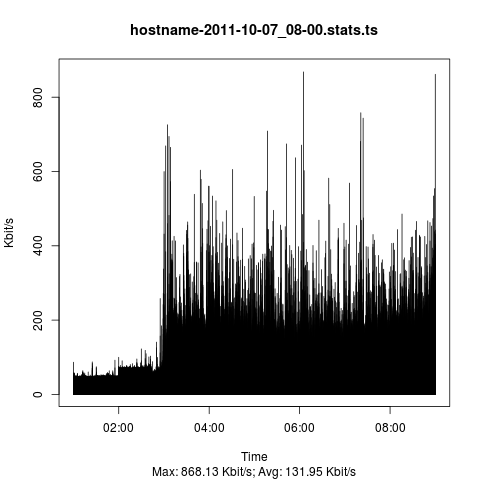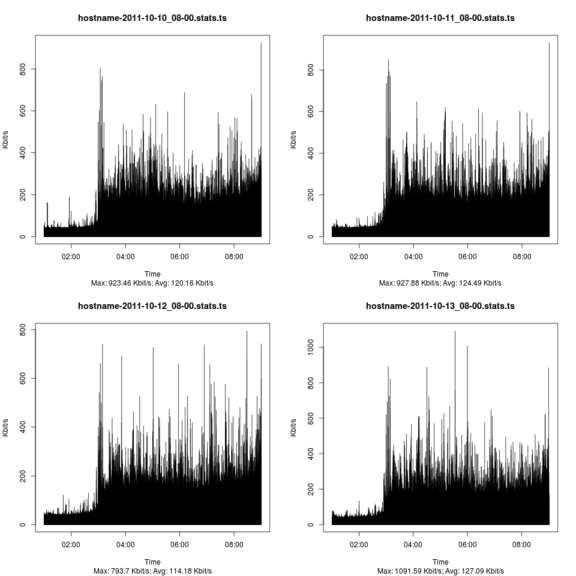Difference between revisions of "Network/Visualize pcap file data"
| Line 27: | Line 27: | ||
006.000-007.000 62 5912 |
006.000-007.000 62 5912 |
||
The only problem with the output above is that the time is relative to the start of the <tt>pcap</tt> file. Before passing the data to <tt>R</tt> it has to be properly massaged. |
The only problem with the output above is that the time is relative to the start of the <tt>pcap</tt> file. Before passing the data to <tt>R</tt> it has to be properly massaged. |
||
=== Convert the time with <tt>ruby</tt> === |
|||
'''Note:''' I'm pretty sure this part could be done in <tt>R</tt> but with the deadline looming I decided to write it in a language I'm familiar with. |
|||
My data captures are usually automated using a script that writes the start date and time into the file name to make it unique. The below <tt>ruby</tt> script assumes the file names being passed to it are in the form of <tt><String>-<span class="highlight">YYYY-MM-DD_hh-mm</span>.stats</tt> |
|||
#!/usr/bin/ruby |
|||
$files = ARGV |
|||
dateRegex = /(\d{4})-(0[1-9]|1[0-2])-(0[0-9]|[12][0-9]|3[01])_([01][0-9]|2[0-4])-([0-5][0-9])/ |
|||
$files.each do |file| |
|||
file.match( dateRegex ) |
|||
$time = Time.local( $1, $2, $3, $4, $5, 0 ) |
|||
$fh = File.open( file + ".ts", "w" ) |
|||
File.open( file ).each do |line| |
|||
# filter lines |
|||
next unless line.match( /^(Time|\d)/ ) |
|||
line.strip! |
|||
if line.sub!( /^(\d+).*?\s(.*)/, '\2' ) |
|||
#line = ( $time + $1.to_i ).strftime( "%H:%M:%S" ) + line |
|||
line = ( $time + $1.to_i ).strftime( "%s" ) + line |
|||
line.gsub!( /\s+/, "\t") |
|||
else |
|||
line.gsub!( /\s+/, "") |
|||
line.gsub!( /\|/, "\t") |
|||
end |
|||
$fh.puts line |
|||
end |
|||
$fh.close |
|||
end |
|||
Invoke the script as shown below assuming the above script is saved as <tt>make-timestamp.rb</tt>. |
|||
ruby make-timestamp.rb *stats |
|||
This will produce a file called <tt><String>-<span class="highlight">YYYY-MM-DD_hh-mm</span>.stats.<span class="highlight">ts</span></tt>. Below is an example of the file. '''Note:''' the time is in Epoch for easier processing in <tt>R</tt>. |
|||
Time frames bytes |
|||
<span class="highlight">1318546800</span> 62 5314 |
|||
1318546801 62 5780 |
|||
1318546802 62 6062 |
|||
1318546803 62 5894 |
|||
1318546804 62 5424 |
|||
1318546805 62 5198 |
|||
1318546806 62 5140 |
|||
1318546807 59 5360 |
|||
1318546808 62 5642 |
|||
=== Produce a graph with <tt>R</tt> === |
=== Produce a graph with <tt>R</tt> === |
||
Revision as of 00:09, 19 July 2012
One nice day I was given orders to produce network usage statistics to find eventual burst in the network stream. I faced two problems with this task. The network monitoring software was graphing the network flow only every minute which was too coarse and the interface was connected to a switch I had no control over at all, A mirror port had to be ruled out. The assignment was to collect data for a week and then look at the numbers.
I was unsure how to go about it in the first place. To not fall behind I ran tcpdump on the hosts in question until the week was over. At that point in time I had no idea how to process the pcap dump data and I had not the faintest clue how to present it at the end of the week. After a lot of searching I finally came across a nifty feature in tshark allowing me to aggregate bandwidth on a per second basis. Below is a short recipe how to create graphs from captured network traffic.
Prerequisites
- A capture file the wireshark suite understands. E.g. pcap or Solaris snoop among others.
- tshark
- ruby
- R
- ImageMagick's montage [optional]
Howto
Aggregate traffic with tshark
To properly graph the data tshark needs to generate statistic on a per second basis. The below command will achive this.
tshark -q -z 'io,stat,1' -r <PcapFile> > <StatisticsFile>
The output is looking something like the excerpt below.
<<<<<<< <StatisticsFile> ======= Time |frames| bytes 000.000-001.000 62 5578 001.000-002.000 62 5386 002.000-003.000 62 5692 003.000-004.000 62 5968 004.000-005.000 62 5428 005.000-006.000 62 5838 006.000-007.000 62 5912
The only problem with the output above is that the time is relative to the start of the pcap file. Before passing the data to R it has to be properly massaged.
Produce a graph with R
Finally to produce the graph in PDF or PNG format the below R script is being used.
#!/usr/bin/Rscript
## ----------------------------------------------------------------------------
## Globals for reading the data file
## ----------------------------------------------------------------------------
skip.header <- 1 # how many lines to skip including the header row
comment.char <- "=" # skip lines with <char> in it
## ----------------------------------------------------------------------------
## Don't touch below unless you know what you are doing
## ----------------------------------------------------------------------------
col.names <- c( "time", "frames", "bytes" )
args <- commandArgs( trailingOnly = TRUE )
number.graphs <- length( args )
for ( d in 1:length( args ) ) {
file <- args[[d]]
# get date and time from file name and convert to a time object
date.time <- as.POSIXlt(
gsub(
".*([0-9]{4}-[0-9]{2}-[0-9]{2})_([0-9]{2})-([0-9]{2}).*",
"\\1 \\2:\\3:00",
file,
perl=T
)
)
# read the data
traffic <- read.table( file=file,
header=F,
col.names=col.names,
skip=skip.header,
comment.char="="
)
# massage the data a bit
traffic$kbits <- ( traffic$bytes * 8 ) / 1024
traffic$frames <- NULL
traffic$bytes <- NULL
traffic$time <- as.numeric(
gsub("-.*", "", traffic$time, perl = T )
) + date.time
# calculate max an avg
traffic.max <- round( max( traffic$kbits ), digits = 2 )
traffic.avg <- round( mean( traffic$kbits ), digits = 2 )
# prepare the graph
sub.title <- paste( "Max:", traffic.max, "Kbit/s; Avg:", traffic.avg, "Kbit/s" )
names( traffic )
# output as pdf and png
pdf( paste( file, ".pdf", sep = "" ) )
plot( traffic, type="h", main=file, sub=sub.title, xlab="Time", ylab="Kbit/s" )
png( paste( file, ".png", sep = "" ) )
plot( traffic, type="h", main=file, sub=sub.title, xlab="Time", ylab="Kbit/s" )
}
To run the script issue the following command assuming the above script is called tshark-graph.R.
Rscript tshark-graph.R *ts
Resulting graph
There are sexier graphs out there but from a functional standpoint it does the job.

Combining graphs
R is fully capabale of creating a collection of graphs from a bunch of files but personally I think it's a lot more involved than simply using ImageMagick's montage command.
montage -geometry <Width>x<Height> <GraphFiles> <OutputGraph>
Yields a similar graph like the one below (intentionally downsampled to fit page)
